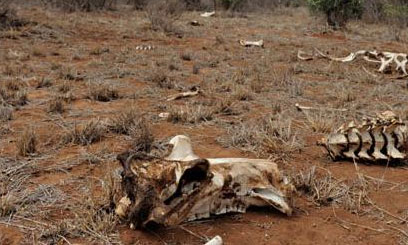NAIROBI, Aug 3 – As warnings grow that famine could engulf all of southern Somalia, the relief efforts needed to ease the crisis are being hampered by escalating conflict and restrictions by rebels on aid groups.
The United Nations last month declared famine in southern Bakool and Lower Shabelle regions in the south of Somalia due to the prolonged drought in the Horn of Africa region.
This week, UN humanitarian chief Valerie Amos warned that famine could spread to five or six regions in Somalia “if we are not able to really handle it now.”
Despite international calls for action and pledges of cash, aid workers say they face a tough challenge to avoid a looming spread of famine.
“The question is whether donors are able to act as urgently and convert money into life-saving action,” Oxfam spokeswoman Elise Ford said.
“The international community is failing to keep pace with a crisis that is spiralling out of control.”
The extreme drought is affecting over 12 million people across the Horn of Africa, but the escalation into famine in southern Somalia is blamed on decades of conflict, and a two-year aid restriction by the Islamist Shebab insurgents.
Renewed bouts of heavy fighting that broke out last week between the African Union-backed Somali government forces and the Al Qaeda-inspired Shebab rebels in Mogadishu are also worsening the crisis.
“The current conflict will cause more civilian casualties and further displacements,” the UN Office for the Coordination of Humanitarian Affairs warned in a statement.
Up to 1,000 people fleeing drought arrive every day at the conflict-ridden Somali capital in a desperate search for food, medicine and water.
Torrential rains around the capital have added to the misery of some 100,000 new arrivals with limited shelter and weakened by hunger, the UN refugee agency said.
“Our ability to deliver much needed aid is being hampered by the ongoing fighting in the Somali capital,” said the UNHCR, adding that its workers are forced to travel in heavily armoured vehicles.
Restrictions in southern Somalia on aid workers are amongst the “most prohibitive in the world,” a recent UN monitoring report on Somalia said.
It named militia groups — and especially the Shebab — as the “greatest obstacle” to humanitarian assistance.
Tens of thousands of Somalis have already died, the UN warns, while some 1.25 million children in southern Somalia need “life saving interventions.”
Nevertheless, some aid is getting through, with around a dozen foreign aid organisations allowed by the Shebab to operate inside their zones of control, but with limited scope.
The International Committee of the Red Cross said Monday it had distributed food to 162,000 people in south and central Somalia.
Yet demands for aid are overwhelming even in the areas where access is relatively open and secure.
In the ever growing refugee camps in Ethiopia and Kenya, hosting mainly Somalis who have fled hunger and conflict, aid groups are struggling to cope with the huge daily influx.
“We are concerned with the huge numbers of people arriving, especially as 60 to 70 percent of them are children, who are always the most vulnerable,” said Fiona Ferguson from Save the Children, speaking in the eastern Kenyan camp of Dadaab, the world’s largest refugee settlement.
But with warnings that conditions are set to worsen, aid workers currently overwhelmed by the humanitarian crisis will likely face increasing pressure ahead.
“Food security is expected to deteriorate over the coming months,” the UN refugee agency said. “By August-September, all regions of southern Somalia are likely to be facing famine.”










































